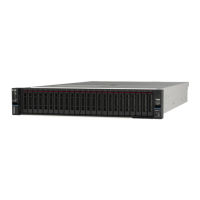• The device is supported by the server (see https://serverproven.lenovo.com).
• The latest version of corresponding driver is installed.
• The device is seated correctly without physical damage on the device or connector.
• System firmware has been updated to the latest version.
• You followed the installation instructions that came with the device, and the device is installed
properly.
• You have not loosened any other installed devices or cables.
3. Reseat the device.
4. Replace the device.
A Lenovo optional device that worked previously does not work now
Complete the following steps until the problem is solved.
1. Check the system event log and resolve any related problems. To view the system event log, go to
Setup Utility and select Event Logs ➙ View Smbios Event Log.
2. Make sure that all of the cables are securely connected.
3. If the device comes with test instructions, use those instructions to test the device.
4. Reseat the failing device.
5. Replace the failing device.
Performance problems
Use this information to solve performance problems.
•
“Network performance” on page 179
• “Operating system performance” on page 179
Network performance
Complete the following steps until the problem is solved:
1. Isolate which network is operating slowly (such as storage, data, and management). You might find it
helpful to use ping tools or operating-system tools such as task manager or resource manager.
2. Check for traffic congestion on the network.
3. Update the NIC device driver, or the storage device controller device driver.
4. Use the traffic-diagnostic tools that are provided by the IO-module manufacturer.
Operating system performance
Complete the following steps until the problem is solved:
1. If you have recently made changes to the server (for example, updated device drivers or installed
software applications), remove the changes.
2. Check for any networking issues.
3. Check the operating system logs for performance related errors.
4. Check for events related to high temperatures and power issues as the server might be throttled to help
with cooling. If it is throttled, reduce the workload on the server to help improve performance.
5. Check for events related to disabled DIMMs. If you do not have enough memory for the application
workload, your operating system will have poor performance.
6. Ensure that the workload is not too high for the configuration.
Chapter 8. Problem determination 179

